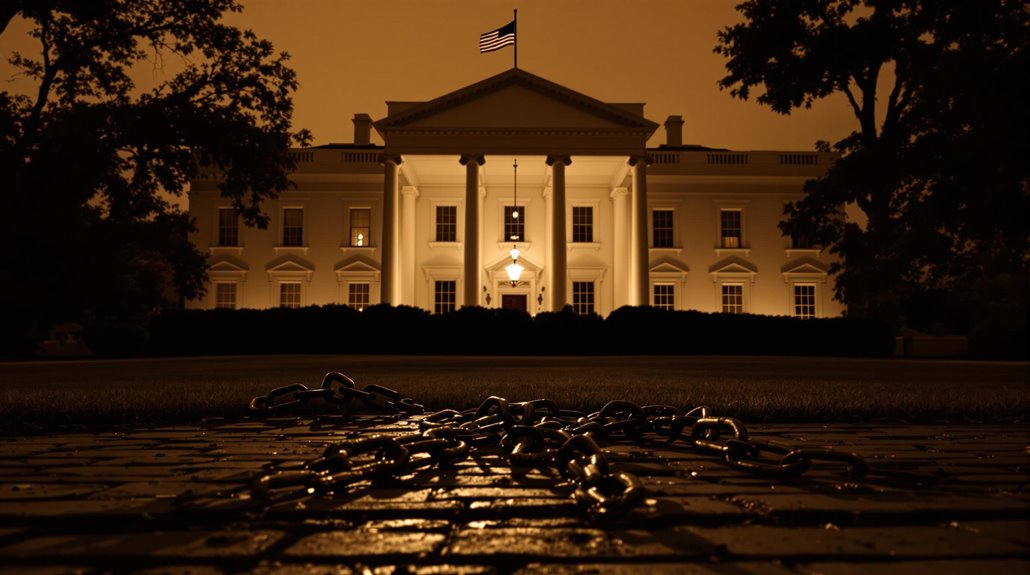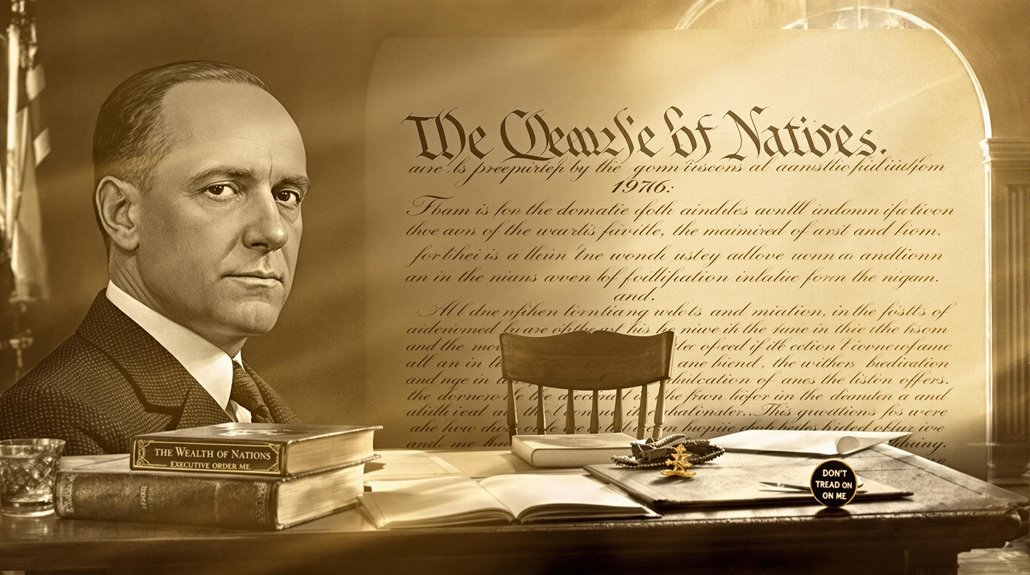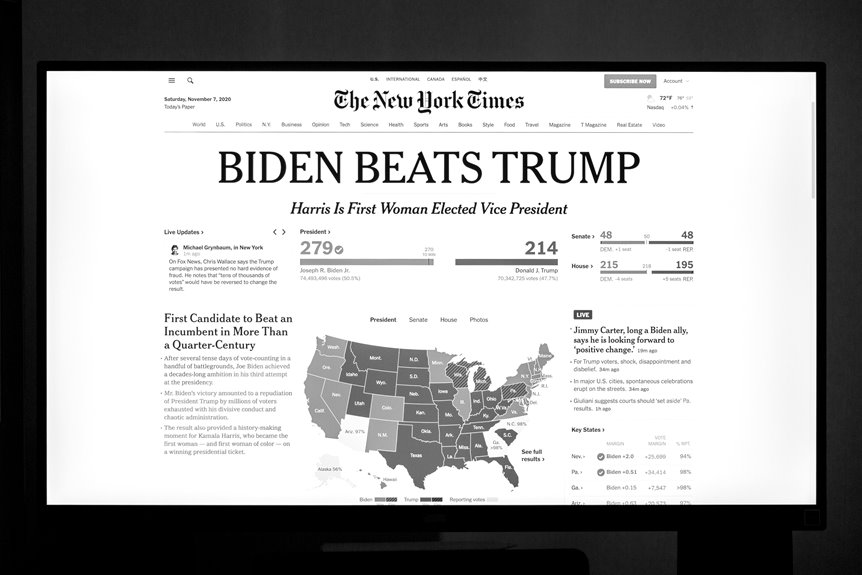You’ll find three U.S. presidents who genuinely championed libertarian principles: Thomas Jefferson, Grover Cleveland, and Calvin Coolidge. Jefferson slashed federal spending and eliminated internal taxes, while Cleveland vetoed 414 bills to fight government overreach. Coolidge’s presidency saw the most dramatic results – cutting federal spending by 50%, reducing top tax rates from 73% to 24%, and transforming a $28 billion debt into a $1 billion surplus. Their records reveal what true small-government leadership looks like.
Defining Libertarian Principles and Presidential Power

Before evaluating which U.S. president best embodied libertarian ideals, we must establish a clear framework for libertarian principles and examine how presidential powers intersect with them.
At its core, libertarian philosophy champions individual liberty, free markets, property rights, and minimal government intervention. You’ll find these principles often clash with presidential authority, which has expanded dramatically since the nation’s founding.
A truly libertarian president would need to actively reduce executive power – a paradox that requires using authority to diminish authority.
When measuring presidential libertarianism, you’ll need to take into account key metrics: Did they reduce regulations? Did they respect states’ rights? Did they avoid foreign interventions? Did they decrease federal spending?
Most critically, did they willingly surrender their own power rather than expanding it?
Thomas Jefferson’s Classical Liberal Legacy
Among all early American presidents, Thomas Jefferson’s presidency stands as the most libertarian-minded administration in U.S. history. Through his vision of Jeffersonian democracy, you’ll find a leader who championed individual rights, limited government intervention, and decentralized power.
You’ll recognize Jefferson’s influence in how he slashed federal spending, eliminated internal taxes, and reduced the national debt by a third. His commitment to classical liberalism shaped policies that empowered states and local communities over federal authority.
Despite controlling the executive branch, he refused to expand presidential powers, even when doing so could’ve advanced his agenda. Jefferson’s actions consistently aligned with libertarian principles: he pardoned those convicted under the Alien and Sedition Acts, opposed federal banking monopolies, and advocated for free trade.
His legacy established a blueprint for minimal government interference in citizens’ daily lives.
Grover Cleveland’s Stand Against Federal Overreach
You’ll find Grover Cleveland’s signature achievement was his stalwart opposition to federal overreach, demonstrated through his record-breaking 414 presidential vetoes.
His most notable stand came in 1887 when he rejected the Texas Seed Bill, which would have provided drought relief to farmers, stating that he could find “no warrant in the Constitution” for such federal assistance.
Cleveland’s dedication to limited government extended to his economic policies, where he fought against inflation, opposed high tariffs, and demanded a return to the gold standard – positions that cost him politically but aligned with classical liberal principles of fiscal restraint.
Vetoing Federal Relief Bills
| Year | Relief Legislation | Cleveland’s Response |
|---|---|---|
| 1887 | Texas Drought Aid | Vetoed |
| 1887 | Seed Distribution | Vetoed |
| 1886 | Disability Relief | Vetoed |
| 1885 | Veterans Benefits | Vetoed |
Limited Government Economic Policies
Cleveland’s economic policies embodied libertarian principles through his fierce opposition to federal market intervention.
You’ll find his steadfast commitment to economic deregulation shaped a presidency focused on keeping government out of private enterprise. He fought relentlessly against corporate subsidies, refused federal bailouts during the 1893 depression, and insisted businesses should succeed or fail on their own merits.
His dedication to fiscal responsibility transformed the treasury’s approach to spending.
You can see this reflected in his systematic reduction of government expenditures and his successful efforts to maintain the gold standard. Cleveland slashed federal spending by 20% during his first term, eliminated patronage positions, and consistently pushed back against congressional attempts to expand federal economic power.
His policies set a precedent for limited government that wouldn’t be matched for generations.
Calvin Coolidge and Economic Freedom
Calvin Coolidge’s libertarian legacy shines through his sweeping tax cuts, which slashed top marginal rates from 73% to 24% between 1921 and 1929, releasing unprecedented economic growth.
You’ll find his commitment to limited government reflected in his aggressive reduction of federal spending, cutting the budget by over 50% during his presidency while paying down the national debt.
His famous declaration that “the business of America is business” wasn’t just rhetoric – Coolidge’s policies created a boom that drove real GDP growth to 42% over his tenure, proving the power of economic freedom.
Tax Cuts and Growth
Under President Calvin Coolidge’s leadership, dramatic tax reductions transformed America’s economic landscape during the Roaring Twenties. His aggressive tax policy slashed the top marginal rate from 73% to 24%, while reducing the federal government’s role in the economy.
You’ll find that federal revenues actually increased during this period, despite lower rates, as economic growth surged.
The economic impact was remarkable. Manufacturing output soared by 64%, unemployment dropped to 3.2%, and real wages grew steadily. You can trace much of the 1920s prosperity to Coolidge’s hands-off approach, letting businesses thrive without excessive taxation.
While critics argued these policies favored the wealthy, the results showed broad-based growth. Workers’ purchasing power expanded, consumer goods became more affordable, and innovation flourished in industries from automobiles to radio manufacturing.
Limited Government Spending
As government spending ballooned during World War I, Coolidge’s response was swift and unyielding.
You’ll find that he slashed the federal budget by 50% during his presidency, bringing spending down from $3.14 billion in 1923 to $1.67 billion in 1929. His obsession with government efficiency became legendary among his peers and critics alike.
You’d be hard-pressed to find another president who scrutinized spending with such determination. He personally reviewed departmental budgets line by line, challenged every expenditure, and frequently responded to spending requests with a simple “no.”
When asked about his aggressive cuts, Coolidge famously remarked, “I believe in budgets. I want other people to believe in them.”
His actions transformed a $28 billion national debt into a $1 billion surplus.
The Historical Context of Presidential Libertarianism
Throughout American history, the principles of libertarianism have clashed with the expanding role of federal power. You’ll find the libertarian influence has waxed and waned, with historical perspectives showing distinct periods of both resistance to and acceptance of government growth.
| Era | Federal Power | Libertarian Response |
|---|---|---|
| 1789-1860 | Limited scope | Strong state autonomy |
| 1861-1932 | Gradual expansion | Mixed opposition |
| 1933-Present | Rapid growth | Vocal resistance |
Today, you’re witnessing the culmination of this centuries-long tension between individual liberty and centralized authority. The pendulum has swung dramatically from the founding fathers’ vision of restricted federal influence to our modern administrative state. Each president’s actions must be evaluated against this evolving backdrop of American governance, where even self-proclaimed liberty advocates have often expanded state power.
Measuring Presidential Actions Against Libertarian Values

When evaluating presidents against libertarian principles, you’ll need clear metrics that cut through political rhetoric and focus on concrete actions.
Key indicators include their expansion or reduction of executive authority, respect for constitutional limits, and protection of individual rights.
You can measure a president’s alignment with libertarian philosophy by examining specific policy decisions. Track their record on free trade, military intervention, regulatory reforms, and monetary policy.
Consider their stance on civil liberties, property rights, and federal spending. Look for instances where they’ve reduced government’s role or defended states’ rights against federal overreach.
Quantifiable metrics matter most: executive orders issued, vetoes of expansionist legislation, budget cuts implemented, and regulations eliminated.
These concrete measures reveal whether a president truly embraced libertarian ideals or merely paid lip service to limited government.
Modern Presidents and Libertarian Ideals
Modern presidents have largely failed to embrace core libertarian principles, with few exceptions worth noting.
You’ll find that most presidential actions since the 1960s have expanded government control, increased spending, and limited individual freedoms. Even self-proclaimed small-government advocates have fallen short of libertarian policies in practice.
Ronald Reagan’s rhetoric championed free markets and limited government, but his administration still grew federal spending by 69%.
Bill Clinton’s deregulation of telecommunications showed promise, yet he expanded federal oversight in other sectors.
More recently, you’ve witnessed both parties push for expanded surveillance powers, foreign interventions, and monetary manipulation through the Federal Reserve.
The rhetoric of liberty frequently gives way to the reality of growing state power, leaving true libertarian principles behind in favor of political expediency.
Conclusion
You’ll find that pinpointing the “most libertarian” president is like trying to catch fog in your hands – it’s more complex than it appears. While Thomas Jefferson best embodied classical liberal principles through his writings and philosophy, Calvin Coolidge’s actions most closely aligned with libertarian values through his hands-off economic policies and devotion to limited government. The reality is that presidential power itself often conflicts with pure libertarian ideals.





